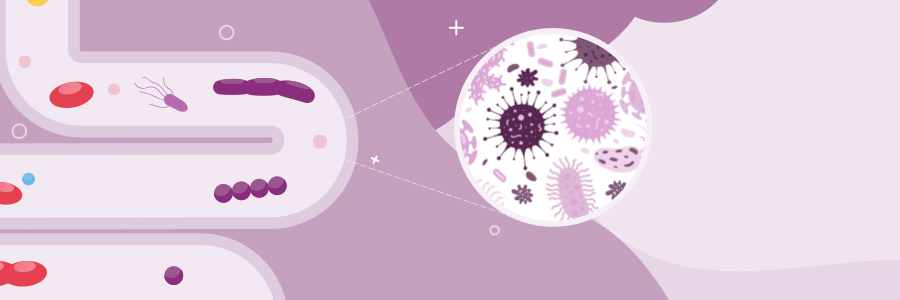


Sign-up for {N}power to get exclusive discounts, newsletters, members-only features, and more!

Have you heard of small intestinal bacterial overgrowth, aka, SIBO? It’s a form of dysbiosis, in which an overgrowth of bacteria in the small intestine can lead to an array of uncomfortable symptoms in the short term, including excessive gas, bloating, diarrhea and/or constipation, and more serious consequences if left untreated. But isn’t bacteria in the gut a good thing? It is—when it remains in the colon, or large intestine, where the majority of gut bacteria should reside. But when bacteria from the colon move into the small intestine and begin to grow there, leading to uncomfortable symptoms, that is SIBO.

Risk factors include low stomach acid, long-term use of proton-pump inhibitors (PPIs), irritable bowel syndrome (IBS), poor pancreatic function, Crohn’s disease, celiac disease, liver disease, diabetes, obesity, and older age.1 2 Those with SIBO share the same cluster of symptoms: severe bloating/abdominal distension, excessive gas, cramping, diarrhea, and/or constipation. Non-GI symptoms may include brain fog, headaches, fatigue, joint pain, and skin conditions, especially if SIBO is left untreated. Long-term symptoms may also include malabsorption of important nutrients, including vitamin B12 and fat-soluble vitamins like vitamin D, which can lead to malnutrition and vitamin deficiencies.3 4 5
 Our guts have several built-in mechanisms to prevent bacterial overgrowth—gastric acid and bile secretion, digestive enzymes, a healthy intestinal mucosal layer, and normal intestinal motility all play a role in preventing excess colonization of the small intestine by bacteria, but if any one of these is compromised, you can become susceptible to developing SIBO. To add insult to injury, SIBO can significantly interfere with these processes and functions, so if you are already starting with an unhealthy gut, SIBO only compounds the problem. It can also lead to increased intestinal permeability (aka, leaky gut) and certain strains of bacteria can produce toxic substances that increase inflammation not only in the gut, but throughout the body.6
Our guts have several built-in mechanisms to prevent bacterial overgrowth—gastric acid and bile secretion, digestive enzymes, a healthy intestinal mucosal layer, and normal intestinal motility all play a role in preventing excess colonization of the small intestine by bacteria, but if any one of these is compromised, you can become susceptible to developing SIBO. To add insult to injury, SIBO can significantly interfere with these processes and functions, so if you are already starting with an unhealthy gut, SIBO only compounds the problem. It can also lead to increased intestinal permeability (aka, leaky gut) and certain strains of bacteria can produce toxic substances that increase inflammation not only in the gut, but throughout the body.6
The least invasive test to diagnose SIBO is a breath test that measures levels of hydrogen and methane. These gases are produced by bacteria that live in our guts and an increase in levels of either of them can indicate an overgrowth of bacteria in the small intestine specifically.7 These tests are widely available—just ask your healthcare provider. Once you have a diagnosis, many practitioners use a “reduce, restore, repopulate” protocol: reduce the bacteria in the small intestine, restore gut health and function, and repopulate the colon with beneficial bacteria.
The first step in treatment is to eliminate the problematic bacteria in the small intestine—this is commonly done via prescription or herbal antimicrobial treatment. Because long-treatment with antibiotics can lead to further dysbiosis, diarrhea, and possibly an increased resistance to antibiotics in general, more people are opting for herbal antimicrobial blends, which have been shown to be as effective as the antibiotic rifaximin, commonly used to treat SIBO.8 9 Along with antimicrobial treatment, a short-term elimination diet is recommended to remove the foods that promote the growth of bacteria. Bacteria living in the small intestine digest sugars and carbohydrates and convert them to gas and other by-products, which can trigger diarrhea, bloating, and other uncomfortable symptoms; eliminating these foods starve the bacteria. In general, it is recommended to avoid sugars, fruits and starchy vegetables, dairy, and grains.10 A low-FODMAP diet is a popular elimination diet for those with SIBO. FODMAP is an acronym for a class of carbohydrates called fermentable short-chain carbohydrates that promote bacteria growth and increase the uncomfortable symptoms of SIBO; they are found in dairy, certain fruits and vegetables, bread and cereals, and legumes. It is typically followed for two to four weeks and then foods are slowly re-introduced to see what triggers your symptoms. Eliminating problematic foods will help reduce symptoms, but also give your gut the chance to heal.
As you work to eliminate bacterial overgrowth, it is also important to work to restore your gut to good health to prevent SIBO from recurring. Nourish your gut with healing foods like bone broth, MCT oil, and ghee; these foods contain compounds that actively help heal the gut lining.11 Digestive enzymes and betaine HCL (hydrochloric acid) improve digestion and restore normal gastric acidity, which helps you better digest food and absorb nutrients while also creating an environment inhospitable to bacteria.12 Apple cider vinegar taken before meals can also support healthy stomach acid production. A combination of peppermint, quebracho tree bark, and horse chestnut, found together in a product called Atrantil™ has been shown to improve symptoms of SIBO with underlying IBS, including bloating, constipation, and abdominal pain.13
The amino acid L-glutamine is one of the best known for healing the lining of the small intestine—the cells of the small intestine use L-glutamine as fuel to create optimal health in the intestinal lining, improving digestion and absorption of nutrients. Research has also found that taking L-glutamine in combination with a low-FODMAP diet significantly improved symptoms of irritable bowel syndrome (IBS), which often occurs in conjunction with SIBO.14
While probiotics are usually best avoided while you work to reduce bacteria in the small intestine, one probiotic in particular—S. boulardii— is the exception. A pilot study published in early 2023 found that S. boulardii, a beneficial yeast, coupled with dietary restrictions, reduced bacterial overgrowth, reduced symptoms, including diarrhea, and led to positive changes in overall intestinal microbiota in SIBO patients.15 Otherwise, probiotics may trigger symptoms, so wait until you have cleared bacteria from the small intestine before you repopulate the colon. Once you are in the clear to do that, probiotics will provide the healthy bacteria you need in the colon to promote overall gut health. Finally, because SIBO can lead to nutrient malabsorption and thus sub-optimal levels of certain nutrients, it’s a good idea to take a quality multivitamin supplement (with special attention to vitamin B12 and fat-soluble vitamins such as vitamin D).
 SIBO is a complex and very individualized condition. If you think you may be suffering from SIBO, reach out to the Nutritional Health Coach at your local Natural Grocers to give you the tools and guidance you need on your healing journey.
SIBO is a complex and very individualized condition. If you think you may be suffering from SIBO, reach out to the Nutritional Health Coach at your local Natural Grocers to give you the tools and guidance you need on your healing journey.



Sign-up for {N}power to get exclusive discounts, newsletters, members-only features, and more!